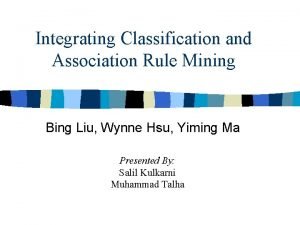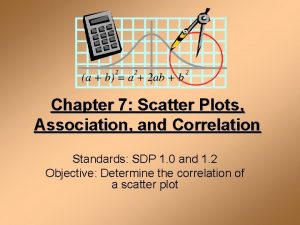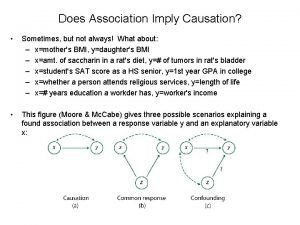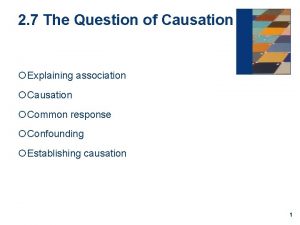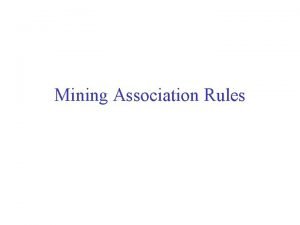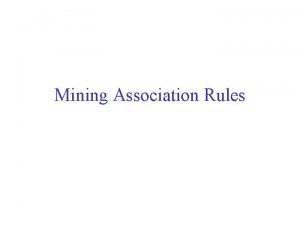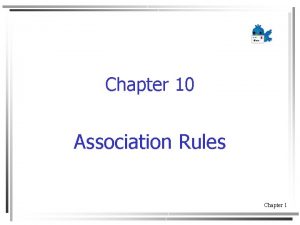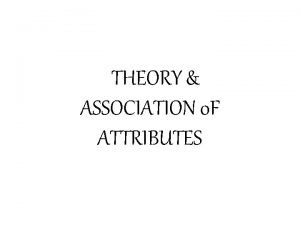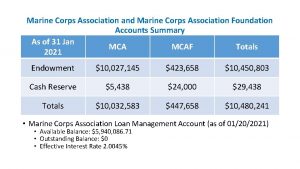Chapter 11 12 13 14 and 16 Association






















- Slides: 22

Chapter 11, 12, 13, 14 and 16 Association at Nominal and Ordinal Level The Procedure in Steps

The Procedure in Steps for Nominal Variables

Step 1: Make Tables o Tables must have a title. o Cells are intersections of columns and rows. o Subtotals are called marginals. o N is reported at the intersection of row and column marginals.

Step 1: Make Tables o Columns are scores of the independent variable. n There will be as many columns as there are scores on the independent variable. o Rows are scores of the dependent variable. n There will be as many rows as there are scores on the dependent variable.

Step 1: Make Tables Title Rows Columns Row 1 cell a cell b Row Marginal 1 Row 2 cell c cell d Row Marginal 2 Column Marginal 1 Column Marginal 2 N

Example of Table o The bivariate table showing the relationship between gender (columns) and party preference (rows). Female Male Labour 8 5 13 Conservatives 4 8 12 12 13 25

Example of Table o The bivariate table showing the relationship between gender (columns) and party preference (rows). Female Male Labour 66. 7% 38. 5% Conservatives 33. 3% 61. 5% 100% (N=12) 100% (N=13)

Step 2: What is the pattern/direction of the association? o See percentages in Table. o Female voters tend to have party preference for Labour and male voters have party preference for Conservatives o This relationship does have a clear pattern o But is it also significant?

Step 3: Is the Association between the Variables Significant? o Chi Square is a test of significance based on bivariate tables. o We are looking for significant differences between the actual cell frequencies in a table (fo) and those that would be expected by random chance (fe).

Example of Computation o Use Formula 11. 2 to find fe. o Multiply column and row marginals for each cell and divide by N. n For Problem above o o (13*12)/25 (13*13)/25 (12*12)/25 (12*13)/25 = = 156/25 169/25 144/25 156/25 = = 6. 24 6. 76 5. 76 6. 24

Example of Computation o Expected frequencies: Female Male Labour 6. 24 6. 76 13 Conservatives 5. 76 6. 24 12 12 13 25

Example of Computation o Divide each of the squared values by the fe for that cell. The sum of this column is chi square fo fe fo - f e (fo - fe)2 /fe 8 6. 24 1. 76 3. 10 . 50 5 6. 76 -1. 76 3. 10 . 46 4 5. 76 -1. 76 3. 10 . 54 8 6. 24 1. 76 3. 10 . 50 25 25 0 χ2 = 2. 00

Example of Computation o See Chapter 11 of Healey (pp. 286 -289) for five-step model for Chi Square Test to find out whether variables are independent/ whether the association between the variables is significant or not o χ2 (critical) = 3. 841 o χ2 (obtained) = 2. 00 o The test statistic is not in the Critical Region. Fail to reject the H 0. o There is no significant relationship between gender and party preference

Interpreting Chi Square o The chi square test tells us only if the variables are independent or not. o Like all tests of hypothesis, chi square is sensitive to sample size. n As N increases, obtained chi square increases. n With large samples, trivial relationships may be significant. o Remember: significance is not the same thing as importance

Step 4: If an Association does Exist, how Strong is it? o It is always useful to compute column percentages for bivariate tables. o But, it is also useful to have a summary measure – a single number – to indicate the strength of the relationship. o For nominal level variables, there are the following commonly used measures of association: n Phi n Cramer’s V n Lambda

Nominal Measures: Phi o See Healey, formula 13. 1, p. 342 o Phi is used for 2 x 2 tables. o The formula for Phi:

Nominal Measures: Cramer’s V o See Healey, formula 13. 2, p. 343 o Cramer’s V is used for tables larger than 2 x 2. o Formula for Cramer’s V:

Nominal Measures: Lambda o See Healey, formula 13. 3, p. 348 o When dependent and independent variables are clear o Formula for Lambda:

Step 5: Is there still an Association, if Control Variables are Added? o See Chapter 16 in Healey o See week 10 of this course

The Procedure in Steps for Ordinal Variables Steps 1 , 2, 3, 5 are similar to those for nominal variables Only step 4 is different, because you need other measures of association

Step 4: If an Association does Exist, how Strong is it? o For ordinal level variables, there are the following commonly used measures of association: n Spearman’s Rho (if there is ranking of scores, see Healey pp. 376 -382) n Gamma (Formula 14. 1, see Healey, p. 366). Is the strength of the relationship significant? Test whether gamma is significant. See Healey, pp. 380 -381

An Ordinal Measure: Gamma o interpret the strength of gamma. o e. g. gamma is 0. 61. o This is a strong association. In addition to strength, gamma also identifies the direction of the relationship. o This is a positive relationship: e. g. as education increases, income increases. o In a negative relationship, the variables would change in the different direction. o Test whether the strength of Gamma is significant Value Strength Between 0. 0 and 0. 30 Weak Between 0. 30 and 0. 60 Moderate Greater than 0. 60 Strong
 Chapter 7 scatterplots association and correlation
Chapter 7 scatterplots association and correlation Chapter 7 scatterplots association and correlation
Chapter 7 scatterplots association and correlation National association of small and medium enterprises
National association of small and medium enterprises Beer and diapers association rule
Beer and diapers association rule International hotel and restaurant association
International hotel and restaurant association Data quality standards iso
Data quality standards iso Integrating classification and association rule mining
Integrating classification and association rule mining Association analysis: basic concepts and algorithms
Association analysis: basic concepts and algorithms Scatter plot and association
Scatter plot and association Association commissural and projection fibers
Association commissural and projection fibers Astdd
Astdd Air movement and control association
Air movement and control association Association of lunar and planetary observers
Association of lunar and planetary observers Society and culture association
Society and culture association National association of deans and directors
National association of deans and directors Association and causation
Association and causation Example of recall bias
Example of recall bias American association on health and disability
American association on health and disability Aircollab
Aircollab Association and causation
Association and causation Association of schools and colleges of optometry
Association of schools and colleges of optometry Manitoba prospectors and developers association
Manitoba prospectors and developers association Library and information technology association
Library and information technology association






